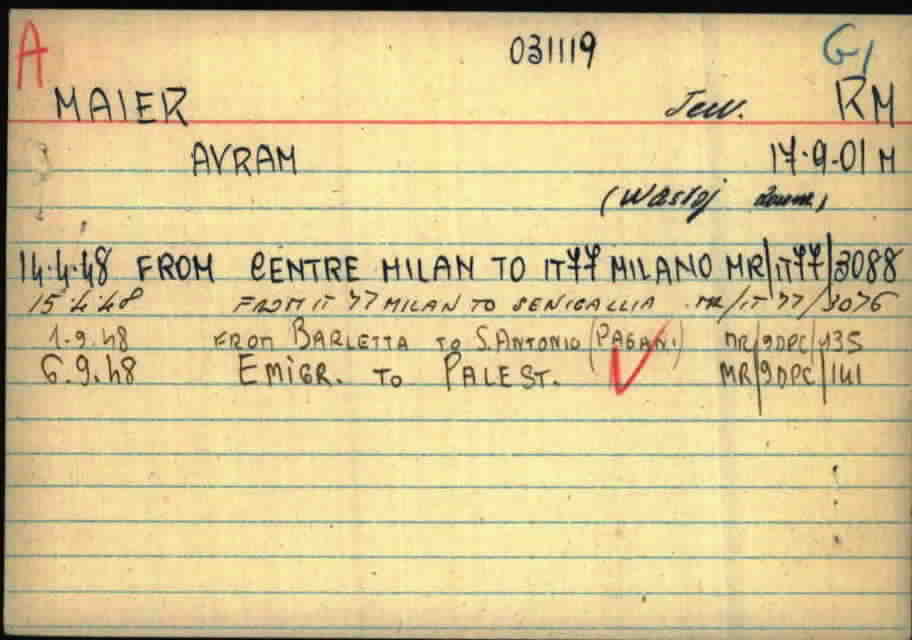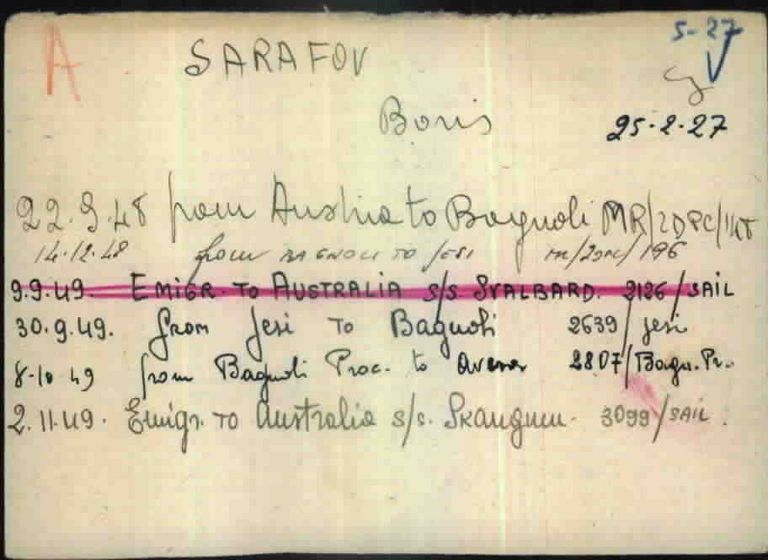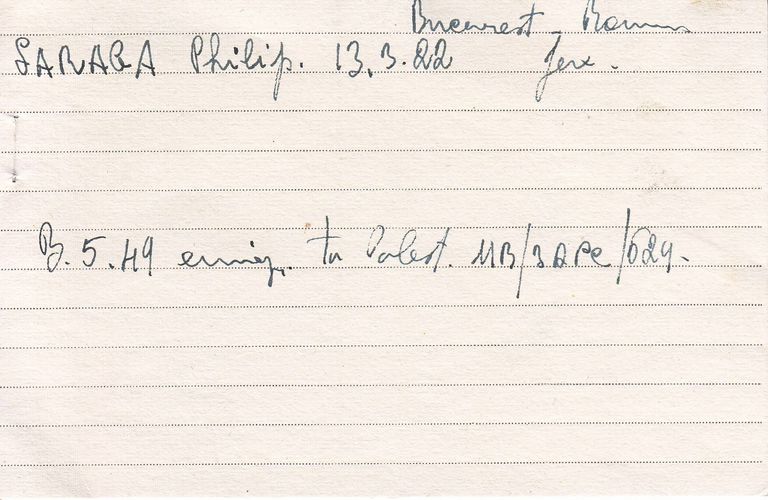Page of
Page/
- Reference
- Intro


There are almost more questions than answers about these cards. At the moment, the evidence indicates that IRO employees filled out the cards in Italy. Handwritten notes on the cards specify when a DP moved from one camp to another or where they had emigrated to. This information was important to the IRO for providing assistance to the DPs.
The information is usually written on lined, white or yellowish index cards. They can be clearly identified by the fact that they were written by hand in English and they mention camps in Italy.
There are almost more questions than answers about these cards. At the moment, the evidence indicates that IRO employees filled out the cards in Italy. Handwritten notes on the cards specify when a DP moved from one camp to another or where they had emigrated to. This information was important to the IRO for providing assistance to the DPs.
The information is usually written on lined, white or yellowish index cards. They can be clearly identified by the fact that they were written by hand in English and they mention camps in Italy.
Questions and answers
-
Where was the document used and who created it?
Unfortunately, there are currently more questions than answers about these index cards. They are clearly cards for Jewish and non-Jewish DPs who were living in Italy after the war. There is therefore a good deal of evidence that IRO employees created these cards in Italy. The time period mentioned on the cards backs this up: all of the dates are between 1947 and 1950, the period in which the IRO was responsible for caring for the DPs. Since the IRO also helped the DPs emigrate, it fits with this assumption that the time spent in DPs camps prior to emigration is also noted on the cards. The different handwriting shows that various people filled out the cards.
- When was the document used?
All of the cards examined thus are from between 1947 and 1950. It can therefore be assumed that the card file was started in 1947. It has yet to be determined whether there is any information from 1951 as well, the last year in which the IRO was responsible for DPs in Italy. The point at which the card file stopped being updated therefore cannot be precisely determined. However, the stamps on the back of the cards reveal that ITS employees filed them in the archive in 1953 and 1954. By this point at the latest, the cards were no longer actively updated and were only used for tracing purposes.
- What was the document used for?
When the IRO took over responsibility for the DPs in July 1947, there were 22 DP camps in Italy. These were located in Bari, Rome, Bologna, Milan, Cremona, Reggio Emilia, Modena, Turin and many other places all over Italy. In the camps in Italy – like those in occupied Germany and Austria – the DPs were grouped together by nationality.
Jews made up the largest group of DPs in Italy. Statistics show that the IRO provided assistance to just over 17,000 people in Italy in July 1947, with more Jewish DPs than in the British occupation zone in Germany. Some of these Jewish DPs had been interned in Italy during the war. However, most of them arrived in the country only after the war had ended. This mainly had to do with illegal emigration to Palestine: an underground organization known as Bricha took Central and Eastern European Holocaust survivors via Italy to Palestine. Researchers estimate that, at least intermittently, there were around 50,000 Jews living in Italy between the summer of 1945 and 1948. Most of them were not registered, however.
The IRO was responsible for both Jewish and non-Jewish DPs in Italy. In December 1946, there were around 38,800 DPs living in Italy. In the four and a half years of its existence, the IRO looked after a total of just over 100,000 DPs in Italy according to its own statistics. The IRO helped 70,535 people to emigrate. To provide this support, it was important to know exactly where the DPs were living. This is probably the reason for the existence of this card file in the Arolsen Archives. Researchers currently assume that IRO employees used the cards to document when DPs moved between camps or emigrated to a different country.
- How common is the document?
It is not possible to say exactly how many IRO cards from Italy are preserved in the Arolsen Archives. This is because the cards are no longer stored together in their own card file; instead, ITS employees reorganized them in the early 1950s following an alphabetical-phonetic system and placed them with other documents in the postwar card file (Nachkriegszeitkartei, Collection 3.1.1.1). This made it easier to search for people, because only one card file had to be consulted instead of several different ones. However, the example of the Temel family shows that probably not all of the index cards ever created in Italy have been preserved. Spot checks have also revealed that the Arolsen Archives do not hold cards for all of the DPs who lived in Italian camps. Unfortunately, it is not possible to say whether these cards never existed or whether they were simply not handed over to the ITS (the predecessor to the Arolsen Archives) in the early 1950s.
- What should be considered when working with the document?
The Arolsen Archives know very little about these index cards, unfortunately. The assumption, based on the available evidence, is that they came from an IRO card file in Italy. However, there is not yet any historical proof of this. Furthermore, there are over 5,000 other cards for DPs in Italy with a similar structure which only arrived in Arolsen in 1985. Researchers have yet to determine how this card index relates to the one received earlier.
If you have any additional information about these cards, we would appreciate it very much if you could send your feedback to eguide@arolsen-archives.org. New findings can always be incorporated into the e-Guide and shared with everyone.
Help for documents
About the scan of this document <br> Markings on scan <br> Questions and answers about the document <br> More sample cards <br> Variants of the document




